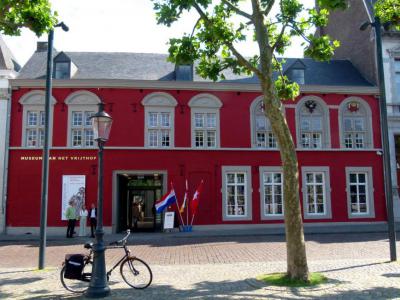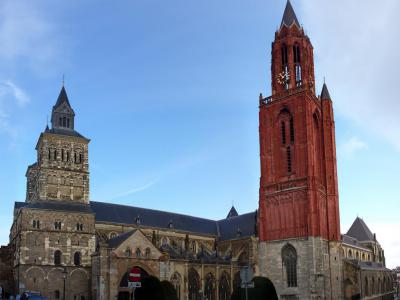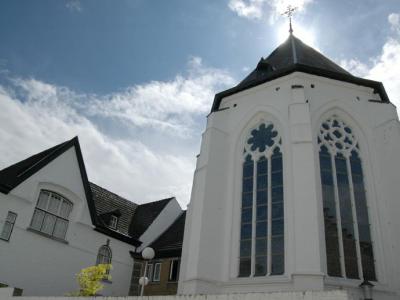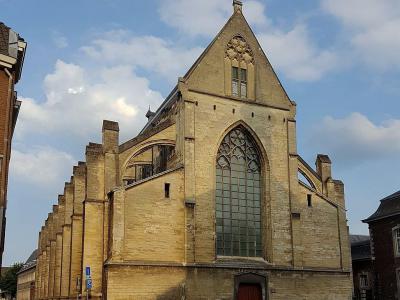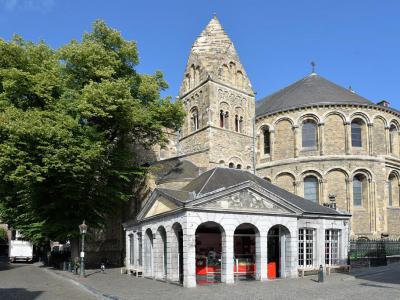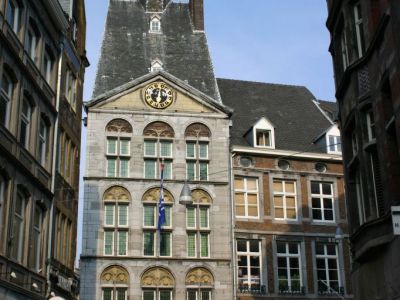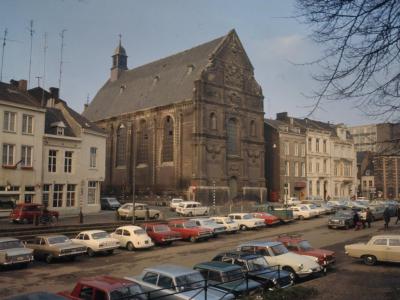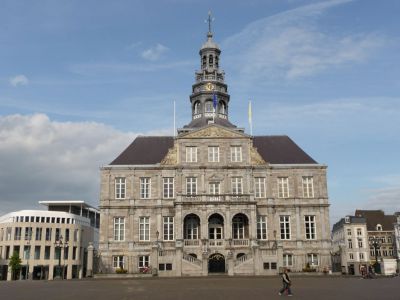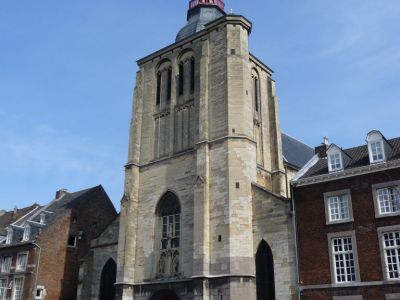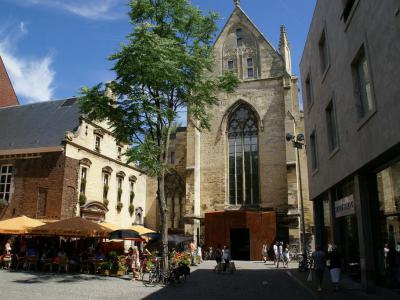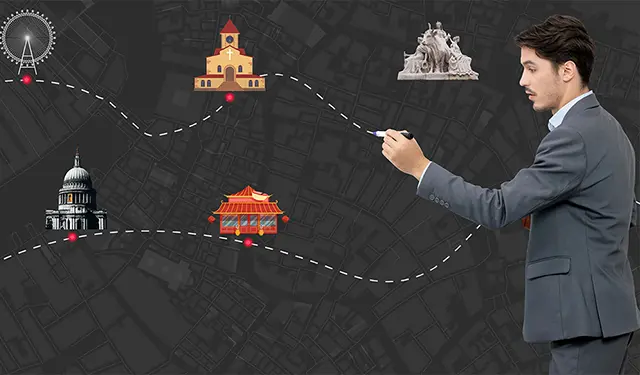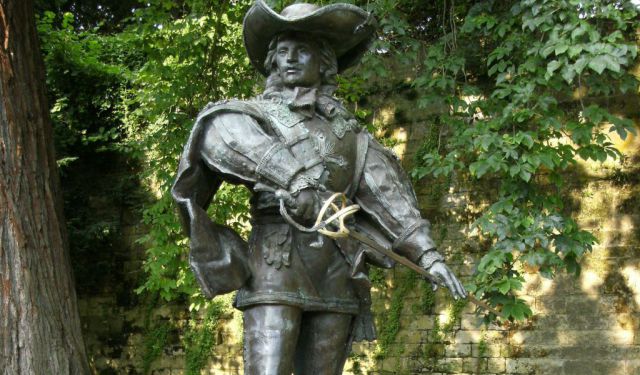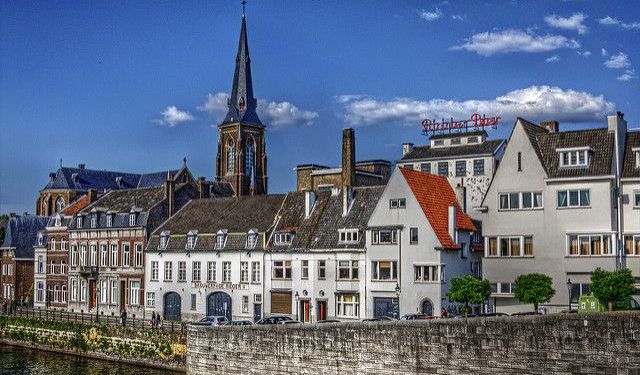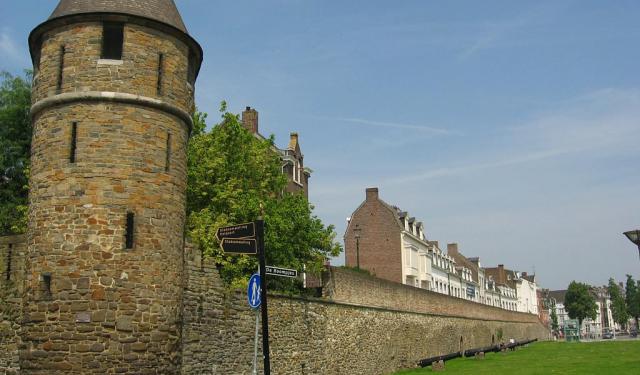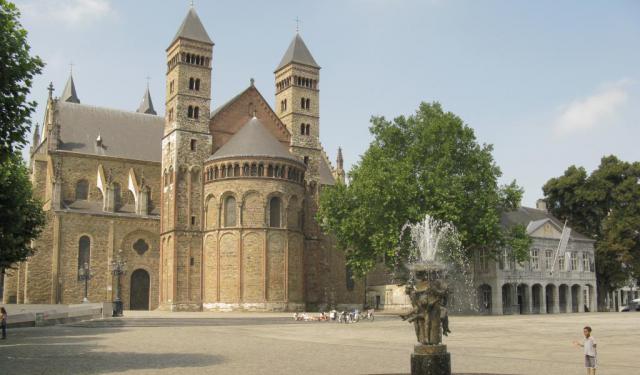
Maastricht's Historical Buildings Walking Tour (Self Guided), Maastricht
Founded by the Romans some 2,000 years ago, the charming city of Maastricht is one of the oldest in the Netherlands. Its long history is manifested in numerous remnants, including religious and secular buildings of any form. Over the course of the centuries, Maastricht has garnered a wealth of architecture, featuring a variety of styles: Gothic, Baroque, Romanesque and Renaissance.
Cultural places as such, these historic structures contribute a great deal to the city's atmosphere. If you like ancient churches and cathedrals, centuries-old civil edifices and other notable locations, you will be quite impressed with Maastricht.
The best place to start exploring this aspect of the city is the magnificent downtown area, called "Vrijthof", one of the most picturesque in Maastricht. Here are some of its architectural marvels worth admiring:
The Saint Servatius Basilica – a true landmark, dominating Maastricht's skyline; the oldest church in Holland (established 1039);
Spaans Gouvernement (Spanish Government Building) – one of the oldest non-religious buildings in Maastricht;
Nieuwenhof Convent and Chapel – a former 15th-century nunnery, now home to the University of Maastricht;
Eerste Minderbroederskerk (First Franciscan Friars’ Church) – a fine example of Maastricht's 13th-century religious architecture;
Dinghuis (Ding House) – another historic monument; former Medieval courthouse – currently home to the Maastricht Tourist Office;
Stadhuis (City Hall) – a site not to miss when in Maastricht, one of the most recognizable pieces of Dutch classicism.
Maastricht has no shortage of lovely historic buildings scattered around the canals, hidden alleys and spacious squares. If you wish to take a proper look at the most fascinating of them, at your own pace and in your good time, take this self-guided walking tour.
Cultural places as such, these historic structures contribute a great deal to the city's atmosphere. If you like ancient churches and cathedrals, centuries-old civil edifices and other notable locations, you will be quite impressed with Maastricht.
The best place to start exploring this aspect of the city is the magnificent downtown area, called "Vrijthof", one of the most picturesque in Maastricht. Here are some of its architectural marvels worth admiring:
The Saint Servatius Basilica – a true landmark, dominating Maastricht's skyline; the oldest church in Holland (established 1039);
Spaans Gouvernement (Spanish Government Building) – one of the oldest non-religious buildings in Maastricht;
Nieuwenhof Convent and Chapel – a former 15th-century nunnery, now home to the University of Maastricht;
Eerste Minderbroederskerk (First Franciscan Friars’ Church) – a fine example of Maastricht's 13th-century religious architecture;
Dinghuis (Ding House) – another historic monument; former Medieval courthouse – currently home to the Maastricht Tourist Office;
Stadhuis (City Hall) – a site not to miss when in Maastricht, one of the most recognizable pieces of Dutch classicism.
Maastricht has no shortage of lovely historic buildings scattered around the canals, hidden alleys and spacious squares. If you wish to take a proper look at the most fascinating of them, at your own pace and in your good time, take this self-guided walking tour.
How it works: Download the app "GPSmyCity: Walks in 1K+ Cities" from Apple App Store or Google Play Store to your mobile phone or tablet. The app turns your mobile device into a personal tour guide and its built-in GPS navigation functions guide you from one tour stop to next. The app works offline, so no data plan is needed when traveling abroad.
Maastricht's Historical Buildings Walking Tour Map
Guide Name: Maastricht's Historical Buildings Walking Tour
Guide Location: Netherlands » Maastricht (See other walking tours in Maastricht)
Guide Type: Self-guided Walking Tour (Sightseeing)
# of Attractions: 12
Tour Duration: 2 Hour(s)
Travel Distance: 3.1 Km or 1.9 Miles
Author: ellen
Sight(s) Featured in This Guide:
Guide Location: Netherlands » Maastricht (See other walking tours in Maastricht)
Guide Type: Self-guided Walking Tour (Sightseeing)
# of Attractions: 12
Tour Duration: 2 Hour(s)
Travel Distance: 3.1 Km or 1.9 Miles
Author: ellen
Sight(s) Featured in This Guide:
- Basilica of Saint Servatius
- Spaans Gouvernement (Spanish Government Building)
- Sint-Janskerk (St. John's Church)
- Nieuwenhofklooster (Nieuwenhof Convent and Chapel)
- Eerste Minderbroederskerk (First Franciscan Friars’ Church)
- Onze-Lieve-Vrouwekerk (Basilica of Our Lady)
- Dinghuis (Ding House)
- Augustijnenkerk (Augustinian Church)
- Stadhuis (City Hall)
- Sint-Matthiaskerk (St. Matthias Church)
- Ursulinenklooster (Ursuline Convent)
- Boekhandel Dominicanen (Dominicanen Bookstore)
1) Basilica of Saint Servatius (must see)
The Romanesque Basilica of Saint Servatius is built on Saint Servatius's gravesite. It is likely that the current structure is the fourth iteration of churches on this site.
Saint Servatius was an Armenian missionary and Tongeren's bishop. He reportedly died in Maastricht in 384. The first church was a small memorial chapel, which was replaced by a larger church. Next, a pilgrim church was built. Finally, the current church was built between the 11th and 12th centuries. Emperor Henry III and a dozen bishops attended the church's dedication in 1039.
The impressive Berg Portal is located on the south side of the church and gives visitors access to the church via descending steps. The portal was probably built during the 12th and 13th centuries and is the first Gothic construction in Maastricht. An intricate tile labyrinth covers the floor.
The portal features vibrantly decorated walls and 72 statues of kings, prophets, apostles, saints, and angels. In addition, reliefs depict Mary's life. In 1566, many statues had their heads removed because of a cultural movement against icons. The damage was poorly repaired in 1596. A Baroque facade was added in the 18th century and removed in the 19th century.
The side chapels were added in the 14th and 15th centuries and feature Gothic architecture. A Gothic spire was added in 1556, and Baroque helmet spires were added in 1770.
French revolutionaries used the church as a horse stable in 1797. As a result, many of the church furnishings were sold or damaged. Since 1866, the church has undergone several restorations.
Throughout the Middle Ages, the Pilgrimage of the Relics took place every seven years. The pilgrimage was revived in the 19th century and again takes place every seven years.
Saint Servatius was an Armenian missionary and Tongeren's bishop. He reportedly died in Maastricht in 384. The first church was a small memorial chapel, which was replaced by a larger church. Next, a pilgrim church was built. Finally, the current church was built between the 11th and 12th centuries. Emperor Henry III and a dozen bishops attended the church's dedication in 1039.
The impressive Berg Portal is located on the south side of the church and gives visitors access to the church via descending steps. The portal was probably built during the 12th and 13th centuries and is the first Gothic construction in Maastricht. An intricate tile labyrinth covers the floor.
The portal features vibrantly decorated walls and 72 statues of kings, prophets, apostles, saints, and angels. In addition, reliefs depict Mary's life. In 1566, many statues had their heads removed because of a cultural movement against icons. The damage was poorly repaired in 1596. A Baroque facade was added in the 18th century and removed in the 19th century.
The side chapels were added in the 14th and 15th centuries and feature Gothic architecture. A Gothic spire was added in 1556, and Baroque helmet spires were added in 1770.
French revolutionaries used the church as a horse stable in 1797. As a result, many of the church furnishings were sold or damaged. Since 1866, the church has undergone several restorations.
Throughout the Middle Ages, the Pilgrimage of the Relics took place every seven years. The pilgrimage was revived in the 19th century and again takes place every seven years.
2) Spaans Gouvernement (Spanish Government Building)
The Spanish Government Building (Spaans Gouvernement) in Maastricht stands as one of the oldest non-religious buildings in the city, prominently facing the Vrijthof square. Its origins trace back to the early 14th century when it was part of the ecclesiastical domain of the Chapter of Saint Servatius. Initially constructed as a half-timbered house for one of the chapter’s canons, the building underwent significant modifications over time.
In the early 16th century, the building was rebuilt and fortified, featuring a single arched gateway. Major changes followed Emperor Charles V’s arrival in 1520, including a marlstone facade with a stone plinth and three Late Gothic arched windows. These windows bore coats of arms, the Habsburg eagle, the pillars of Hercules, and Charles V’s motto, PLUS OULTRE.
The building changed hands over the centuries, from the canons of Saint Servatius to the Duchy of Brabant, serving as a ducal residence. In 1954, art collectors Frederik Wagner and Ambrosina de Wit bequeathed their collection to Maastricht, leading to its transformation into the Spanish Government Museum in 1973. The museum showcased the Wagner-De Wit collection in restored 17th- and 18th-century interiors.
Further renovations and expansions took place between 2010 and 2012, including the incorporation of a neighboring building and the roofing of the courtyard. The museum, later renamed Museum at the Vrijthof, transitioned into a photography-focused institution in 2019. Since 2020, it has been known as the Photo Museum at the Vrijthof, continuing the building’s legacy as a cultural and historical landmark in Maastricht.
Throughout its history, the Spanish Government Building has witnessed centuries of change, from its origins as a medieval residence to its role in Maastricht’s political and cultural evolution. Today, it stands as a testament to the city’s rich heritage, offering visitors an opportunity to explore both its architectural grandeur and its artistic collections.
In the early 16th century, the building was rebuilt and fortified, featuring a single arched gateway. Major changes followed Emperor Charles V’s arrival in 1520, including a marlstone facade with a stone plinth and three Late Gothic arched windows. These windows bore coats of arms, the Habsburg eagle, the pillars of Hercules, and Charles V’s motto, PLUS OULTRE.
The building changed hands over the centuries, from the canons of Saint Servatius to the Duchy of Brabant, serving as a ducal residence. In 1954, art collectors Frederik Wagner and Ambrosina de Wit bequeathed their collection to Maastricht, leading to its transformation into the Spanish Government Museum in 1973. The museum showcased the Wagner-De Wit collection in restored 17th- and 18th-century interiors.
Further renovations and expansions took place between 2010 and 2012, including the incorporation of a neighboring building and the roofing of the courtyard. The museum, later renamed Museum at the Vrijthof, transitioned into a photography-focused institution in 2019. Since 2020, it has been known as the Photo Museum at the Vrijthof, continuing the building’s legacy as a cultural and historical landmark in Maastricht.
Throughout its history, the Spanish Government Building has witnessed centuries of change, from its origins as a medieval residence to its role in Maastricht’s political and cultural evolution. Today, it stands as a testament to the city’s rich heritage, offering visitors an opportunity to explore both its architectural grandeur and its artistic collections.
3) Sint-Janskerk (St. John's Church)
The Protestant Saint John's Church is immediately next to the Roman Catholic Basilica of Saint Servatius. The churches are often referred to as the church twins.
Saint John's Church is named after John the Baptist and was founded around 1200 by the chapter of Saint Servatius to function as a baptismal and parish church for the parish of Saint Servatius. This relieved the load on the Saint Servatius Church and allowed it to function exclusively as a collegiate and pilgrimage church.
Saint John was one of Masstricht's four Catholic parish churches during the Middle Ages. The current structure was built in the 14th and 15th centuries. The Gothic baptistery was added in 1414.
During the medieval times, on the Saturdays before Easter and Pentecost, the canons of Saint Servatius went in procession to Saint John to consecrate the baptismal water. On that occasion, the church choir sang to the canons from the first transept of Saint John's.
Saint John's became a Protestant church in 1632, while Saint Servatius remained a Catholic church. Some original Catholic wall paintings remain in Saint John's.
The interior features an impressive rib vault. The polychrome corbels feature angels, bishops, and the twelve apostles.
The church has had dozens of renovations over the years. The church has many detailed furnishings, including a Baroque Louis XVI-style pulpit that dates to 1779. The church's organ was built in 1992 using the organ case from 1780.
Saint John's main feature is its red 79-meter (259 feet) tall tower built in the 15th century after the previous tower collapsed. The tower includes a wooden belfry and a 1687 bell. A small bell, the so-called gate bell, used to be rung daily to open and close the city gates, but sadly it was stolen in 1943 by the German occupiers.
Visitors can climb the tower's 218 narrow steps to the belfry's viewing platform for a stunning view of the city.
Saint John's Church is named after John the Baptist and was founded around 1200 by the chapter of Saint Servatius to function as a baptismal and parish church for the parish of Saint Servatius. This relieved the load on the Saint Servatius Church and allowed it to function exclusively as a collegiate and pilgrimage church.
Saint John was one of Masstricht's four Catholic parish churches during the Middle Ages. The current structure was built in the 14th and 15th centuries. The Gothic baptistery was added in 1414.
During the medieval times, on the Saturdays before Easter and Pentecost, the canons of Saint Servatius went in procession to Saint John to consecrate the baptismal water. On that occasion, the church choir sang to the canons from the first transept of Saint John's.
Saint John's became a Protestant church in 1632, while Saint Servatius remained a Catholic church. Some original Catholic wall paintings remain in Saint John's.
The interior features an impressive rib vault. The polychrome corbels feature angels, bishops, and the twelve apostles.
The church has had dozens of renovations over the years. The church has many detailed furnishings, including a Baroque Louis XVI-style pulpit that dates to 1779. The church's organ was built in 1992 using the organ case from 1780.
Saint John's main feature is its red 79-meter (259 feet) tall tower built in the 15th century after the previous tower collapsed. The tower includes a wooden belfry and a 1687 bell. A small bell, the so-called gate bell, used to be rung daily to open and close the city gates, but sadly it was stolen in 1943 by the German occupiers.
Visitors can climb the tower's 218 narrow steps to the belfry's viewing platform for a stunning view of the city.
4) Nieuwenhofklooster (Nieuwenhof Convent and Chapel)
Built up against the inside of the Maastricht city wall, the Zwingelput 4 complex, formally known as the ‘Nieuwenhof’ (Nieuwenhofklooster or Klooster van de Nieuwenhof) is a former nunnery.
Over the centuries this complex has served a variety of purposes. Originally built in 1484-1489 as a beguinage (a convent-like institution for devout lay women), by 1625 it had become a proper convent whose nuns cared for the ill. In 1652 the nunnery was expanded, but in 1788 it went bankrupt due to mismanagement and during the French period was closed down. In 1797 the complex was repurposed as a Catholic poorhouse to accommodate needy orphans. The Nieuwenhof served as a children’s home up until 1980.
In 1981 the property was taken over by the University of Maastricht, which radically renovated it. Following that, the then recently-established UM Faculty of Law moved onto the premises in 1982. The faculty moved out in 1998, making way for University College in the Nieuwenhof.
Part of the complex, situated within a walking distance from the bank of the River Maas, is the Nieuwenhof Chapel – a mid-sized octagonal Gothic structure built in 1492-1493. The structure was converted into a lecture hall in 2002. To retain its spaciousness, the lecture hall was situated in the open area like a piece of wooden furniture. Incidentally, the hall is oriented towards the rood loft rather than the altar. During the renovation, a common room with a glazed roof was also constructed, creating a kind of covered courtyard.
Both the chapel and the remaining monastic buildings, some of which, including lower parts of the Zwingelput complex, date from 1652, now represent a national monument.
Over the centuries this complex has served a variety of purposes. Originally built in 1484-1489 as a beguinage (a convent-like institution for devout lay women), by 1625 it had become a proper convent whose nuns cared for the ill. In 1652 the nunnery was expanded, but in 1788 it went bankrupt due to mismanagement and during the French period was closed down. In 1797 the complex was repurposed as a Catholic poorhouse to accommodate needy orphans. The Nieuwenhof served as a children’s home up until 1980.
In 1981 the property was taken over by the University of Maastricht, which radically renovated it. Following that, the then recently-established UM Faculty of Law moved onto the premises in 1982. The faculty moved out in 1998, making way for University College in the Nieuwenhof.
Part of the complex, situated within a walking distance from the bank of the River Maas, is the Nieuwenhof Chapel – a mid-sized octagonal Gothic structure built in 1492-1493. The structure was converted into a lecture hall in 2002. To retain its spaciousness, the lecture hall was situated in the open area like a piece of wooden furniture. Incidentally, the hall is oriented towards the rood loft rather than the altar. During the renovation, a common room with a glazed roof was also constructed, creating a kind of covered courtyard.
Both the chapel and the remaining monastic buildings, some of which, including lower parts of the Zwingelput complex, date from 1652, now represent a national monument.
5) Eerste Minderbroederskerk (First Franciscan Friars’ Church)
Tucked away on Sint Pieterstraat, the First Franciscan Friars’ Church is the last standing remnant of the Old Franciscan Monastery (Oude Minderbroederklooster), founded in 1234. Its construction began just before 1300 and wrapped up a century later, resulting in a spacious, unembellished Maas-Gothic preachery—no tower, no frills, just solemn grandeur. The materials? Limburg marl, resting on a sturdy base of coal sandstone—a testament to medieval durability.
Through the centuries, this monastery complex has had more secular than sacred roles. After the Franciscans were expelled in 1639, the buildings played musical chairs with their functions: an orphanage, an arsenal, a military hospital, and an archive, among others. The church itself weathered the passage of time, albeit not without scars—in 1506, a storm sent its roof turret crashing through the ceiling, obliterating the grand altar. The replacement cycle began soon after: a Baroque altar in 1624, followed by a neo-Gothic one in 1852.
Despite its changing fortunes, traces of its monastic past remain. The 16th-century wall and vault paintings, though rare survivors, still adorn parts of the marlstone rood screen and the vault. The choir area harbors thirteen ancient gravestones, some dating as far back as the 13th century. These fragments, along with the carefully preserved artistic details, whisper of a time when the church stood as a beacon of Franciscan spirituality in Maastricht.
Today, this nearly 700-year-old structure stands as both a historical artifact and a testament to adaptation—more secular than sacred, yet still undeniably steeped in its medieval past.
Through the centuries, this monastery complex has had more secular than sacred roles. After the Franciscans were expelled in 1639, the buildings played musical chairs with their functions: an orphanage, an arsenal, a military hospital, and an archive, among others. The church itself weathered the passage of time, albeit not without scars—in 1506, a storm sent its roof turret crashing through the ceiling, obliterating the grand altar. The replacement cycle began soon after: a Baroque altar in 1624, followed by a neo-Gothic one in 1852.
Despite its changing fortunes, traces of its monastic past remain. The 16th-century wall and vault paintings, though rare survivors, still adorn parts of the marlstone rood screen and the vault. The choir area harbors thirteen ancient gravestones, some dating as far back as the 13th century. These fragments, along with the carefully preserved artistic details, whisper of a time when the church stood as a beacon of Franciscan spirituality in Maastricht.
Today, this nearly 700-year-old structure stands as both a historical artifact and a testament to adaptation—more secular than sacred, yet still undeniably steeped in its medieval past.
6) Onze-Lieve-Vrouwekerk (Basilica of Our Lady) (must see)
The Basilica of Our Lady is a Romanesque Roman Catholic Church, often called Star of the Sea, after the church's main devotion, Our Lady, Star of the Sea.
It's possible that a Roman temple was built on this site before the church was built. Most of the present structure was built in the 11th and 12th centuries. The westwork was built in the 11th century, and Gothic vaults were added in the 13th century.
The French Occupation used the church as a stable and a blacksmith shop during the 1790s. The church was finally returned to a place of worship in 1837.
Visitors can access the church from the Square of Our Lady through a 13th-century Gothic portal.
The interior features a 14th-century mural depicturing Saint Catherine. A mural from 1571 depicts Saint Christopher and the Infant Jesus. The church features a 1652 pipe organ, while the stained glass windows date to the 19th and 20th centuries.
Twenty symbolic capitals carved in the 12th century depict Old Testament scenes. Impressive artworks include a 14th-century Pieta sculpture, a 16th-century wood panel The Dream of Jacob, and two 15th century Virgin Mary statues.
The church features a cloistered garden that dates to the 16th century.
A 15th-century wooden statue of Our Lady, Star of the Sea is located in a chapel by the main entrance. Pope Pius X crowned the statue in 1912. The statue is carried around town during religious processions.
The Basilica of Our Lady houses an impressive treasury. The treasury includes busts of silver and copper, chalices, ancient vestments, antique books, paintings, and sculptures. Items include a 10th-century reliquary horn and the ancient Robe of Saint Lambert.
The main attraction of the Basilica of Our Lady is arguably the miraculous statue of Our Lady, Star of the Sea. This 15th-century wooden statue was originally housed in a nearby Franciscan monastery. It was moved to the Basilica of Our Lady in 1837. You can find the statue placed in a Gothic chapel near the main entrance where it is visited by hundreds of worshipers daily.
It's possible that a Roman temple was built on this site before the church was built. Most of the present structure was built in the 11th and 12th centuries. The westwork was built in the 11th century, and Gothic vaults were added in the 13th century.
The French Occupation used the church as a stable and a blacksmith shop during the 1790s. The church was finally returned to a place of worship in 1837.
Visitors can access the church from the Square of Our Lady through a 13th-century Gothic portal.
The interior features a 14th-century mural depicturing Saint Catherine. A mural from 1571 depicts Saint Christopher and the Infant Jesus. The church features a 1652 pipe organ, while the stained glass windows date to the 19th and 20th centuries.
Twenty symbolic capitals carved in the 12th century depict Old Testament scenes. Impressive artworks include a 14th-century Pieta sculpture, a 16th-century wood panel The Dream of Jacob, and two 15th century Virgin Mary statues.
The church features a cloistered garden that dates to the 16th century.
A 15th-century wooden statue of Our Lady, Star of the Sea is located in a chapel by the main entrance. Pope Pius X crowned the statue in 1912. The statue is carried around town during religious processions.
The Basilica of Our Lady houses an impressive treasury. The treasury includes busts of silver and copper, chalices, ancient vestments, antique books, paintings, and sculptures. Items include a 10th-century reliquary horn and the ancient Robe of Saint Lambert.
The main attraction of the Basilica of Our Lady is arguably the miraculous statue of Our Lady, Star of the Sea. This 15th-century wooden statue was originally housed in a nearby Franciscan monastery. It was moved to the Basilica of Our Lady in 1837. You can find the statue placed in a Gothic chapel near the main entrance where it is visited by hundreds of worshipers daily.
7) Dinghuis (Ding House)
The Ding House (Dinghuis) is a historic building in the heart of Maastricht. Constructed around 1470, it originally served as the headquarters of the high court for both Brabant and Liege, reflecting its judicial function as a "ding" (the Dutch term for a judicial assembly). The building with its rich history and striking Gothic architecture, stands as a reminder of Maastricht's administrative past.
The original structure was primarily half-timbered, with the side facade on Jodenstraat still showcasing this early construction style. The northern facade, also timber-framed, was filled in with bricks in 1699. The main facade, built from Namur stone and marl in the mid-16th century, gives the building its stately presence. A neoclassical pediment, added in 1793, crowns the structure and houses a grand medieval clock that still operates today—though with only one hand, a remnant of its primitive design.
At the time of its construction, the Ding House was the tallest building in Maastricht, strategically located at the intersection of the Kleine Staat, Grote Staat, Muntstraat, and Jodenstraat. Its steeply pitched roof, topped with a late Baroque ridge turret, once functioned as a lookout point and remains a prominent feature of Maastricht’s skyline, particularly when viewed from the Wyck neighborhood across the Maas River.
The Ding House ceased being a courthouse in 1664 and later hosted various institutions, including a prison, a school, a chamber of commerce, and a puppet theater. It briefly served as a theater in 1713 and narrowly escaped demolition in 1860. Restored in 1974, it became Maastricht's Tourist Office, a role it still holds today.
Whether admired for its Gothic craftsmanship, its judicial legacy, or its resilience through centuries of urban change, the Ding House remains an essential landmark in Maastricht’s historical tapestry.
The original structure was primarily half-timbered, with the side facade on Jodenstraat still showcasing this early construction style. The northern facade, also timber-framed, was filled in with bricks in 1699. The main facade, built from Namur stone and marl in the mid-16th century, gives the building its stately presence. A neoclassical pediment, added in 1793, crowns the structure and houses a grand medieval clock that still operates today—though with only one hand, a remnant of its primitive design.
At the time of its construction, the Ding House was the tallest building in Maastricht, strategically located at the intersection of the Kleine Staat, Grote Staat, Muntstraat, and Jodenstraat. Its steeply pitched roof, topped with a late Baroque ridge turret, once functioned as a lookout point and remains a prominent feature of Maastricht’s skyline, particularly when viewed from the Wyck neighborhood across the Maas River.
The Ding House ceased being a courthouse in 1664 and later hosted various institutions, including a prison, a school, a chamber of commerce, and a puppet theater. It briefly served as a theater in 1713 and narrowly escaped demolition in 1860. Restored in 1974, it became Maastricht's Tourist Office, a role it still holds today.
Whether admired for its Gothic craftsmanship, its judicial legacy, or its resilience through centuries of urban change, the Ding House remains an essential landmark in Maastricht’s historical tapestry.
8) Augustijnenkerk (Augustinian Church)
The Augustinian Church is a Baroque church situated in the heart of Maastricht, along the Kesselskade on the banks of the Maas River. Originally built as a monastery church for the Augustinian Order, its construction spanned half a century, from 1609 to 1659, reflecting early Liège Baroque influences. The project was financed by Edmond Godfried van Bocholtz, Grand Commander of the Biesen bailiff of the Knights of the Teutonic Order, and his predecessor Godfried Huyn van Geleen, whose coat of arms prominently adorns the church’s façade.
One of the most remarkable features of the eastern façade is its ornate design, decorated with large volutes and festoons. Below the central round-arch window, the city arms of Maastricht take pride of place, while the top of the façade features a striking relief of the flaming heart of Saint Augustine. Above the entrance, a cartouche bears the inscription from 1659, dedicating the church to Saint Mary, Pope Augustine, and Saint Hubertus.
Constructed with brick, marl, and Namur stone, the Augustinian Church follows a non-oriented, single-aisled hall layout. The wooden barrel vault spans five bays, with large clear windows on the southern side providing ample light. A ridge turret sits atop the slate-covered saddleback roof, near its western end. Between the nave and the presbytery, a triumphal arch showcases intricate Louis XV Rococo-style stucco work. The choir, a later addition from the early 20th century, houses a magnificent stained glass window by Huib Luns (1925), illustrating The Last Supper.
Following the secularization at the end of the 18th century, the monastery was dissolved, and the church took on various roles over time. Today, it serves as a rehearsal space for the Maastricht Choral Society, with sound-absorbing modifications made to the interior. Despite these adaptations, the Augustinian Church retains its historic grandeur and has been officially designated a national monument since 1966.
One of the most remarkable features of the eastern façade is its ornate design, decorated with large volutes and festoons. Below the central round-arch window, the city arms of Maastricht take pride of place, while the top of the façade features a striking relief of the flaming heart of Saint Augustine. Above the entrance, a cartouche bears the inscription from 1659, dedicating the church to Saint Mary, Pope Augustine, and Saint Hubertus.
Constructed with brick, marl, and Namur stone, the Augustinian Church follows a non-oriented, single-aisled hall layout. The wooden barrel vault spans five bays, with large clear windows on the southern side providing ample light. A ridge turret sits atop the slate-covered saddleback roof, near its western end. Between the nave and the presbytery, a triumphal arch showcases intricate Louis XV Rococo-style stucco work. The choir, a later addition from the early 20th century, houses a magnificent stained glass window by Huib Luns (1925), illustrating The Last Supper.
Following the secularization at the end of the 18th century, the monastery was dissolved, and the church took on various roles over time. Today, it serves as a rehearsal space for the Maastricht Choral Society, with sound-absorbing modifications made to the interior. Despite these adaptations, the Augustinian Church retains its historic grandeur and has been officially designated a national monument since 1966.
9) Stadhuis (City Hall)
The City Hall (Stadhuis) of Maastricht, an architectural jewel of Dutch classicism, has stood at the heart of Markt Square since the 17th century, embodying the city's historical and political legacy. Designed by Pieter Post, one of the foremost architects of the Dutch Golden Age, this five-story structure is clad entirely in Namur stone, its dignified presence crowned by a stately slate roof.
Construction began in 1659, with a ceremonial foundation stone marking the occasion—along with a lead box of coins and a commemorative copper plaque entombed in the southwest corner. By 1664, the municipal council had settled into its new quarters, although the tower’s completion was postponed until 1684 due to financial constraints. Today, the 25-meter tower houses a 49-bell carillon, which tolls automatically every half hour.
The façade features symbolic sculptural elements: a city maiden bearing the Maastricht coat of arms is flanked by Mars, representing the city's resilience, and Minerva, signifying wisdom with her Medusa-adorned shield and owl companion. Inside, the richly decorated rooms—largely shaped in the 18th century following damage during the 1793 French bombardment—reflect Maastricht’s divided historical allegiances. The north half of the building represents Liège, while the south half stands for Brabant, with Liège’s quarters given precedence due to the rank of the Prince-Bishop over the Duke of Brabant.
More than just a municipal hall, the City Hall once accommodated the city’s entire civil infrastructure, including a library, archives, prison, weigh house, and carpentry yard. Interrogation rooms, cells, and jailers' quarters occupied the lower levels, a stark contrast to the grandeur above. Today, while the building serves its administrative function, it remains a powerful symbol of Maastricht’s enduring history and architectural splendor.
Construction began in 1659, with a ceremonial foundation stone marking the occasion—along with a lead box of coins and a commemorative copper plaque entombed in the southwest corner. By 1664, the municipal council had settled into its new quarters, although the tower’s completion was postponed until 1684 due to financial constraints. Today, the 25-meter tower houses a 49-bell carillon, which tolls automatically every half hour.
The façade features symbolic sculptural elements: a city maiden bearing the Maastricht coat of arms is flanked by Mars, representing the city's resilience, and Minerva, signifying wisdom with her Medusa-adorned shield and owl companion. Inside, the richly decorated rooms—largely shaped in the 18th century following damage during the 1793 French bombardment—reflect Maastricht’s divided historical allegiances. The north half of the building represents Liège, while the south half stands for Brabant, with Liège’s quarters given precedence due to the rank of the Prince-Bishop over the Duke of Brabant.
More than just a municipal hall, the City Hall once accommodated the city’s entire civil infrastructure, including a library, archives, prison, weigh house, and carpentry yard. Interrogation rooms, cells, and jailers' quarters occupied the lower levels, a stark contrast to the grandeur above. Today, while the building serves its administrative function, it remains a powerful symbol of Maastricht’s enduring history and architectural splendor.
10) Sint-Matthiaskerk (St. Matthias Church)
The Saint Matthias Church is a Gothic church in the heart of Maastricht. As one of the four Roman Catholic parish churches in the city center, it is dedicated to the apostle Matthias. Behind the church, a former cemetery later became a parsonage garden, bordered by the Saint Anthony Chapel.
The foundation stone of the current church was laid in 1351, but records indicate a church existed on this site as early as 1297-98. Built in Maas Gothic style, Saint Matthias Church features a three-aisled marl stone structure atop a Namur stone plinth. Its unfinished three-section tower, with a stair turret on the southwest, is slightly misaligned with the main axis. The 1769 tower crown complements the west entrance, set beneath a neo-Gothic Calvary sculpture from 1882. The basilical nave has a higher choir, a sacristy to the north, and a neo-Gothic baptistery from 1859 to the south.
Inside, the church features a six-bay nave, a two-bay high chancel, and lower aisles. Irregular columns with varied capitals, some Maas-style, separate the aisles from the nave. Vault ribs rest on carved consoles depicting angels and coats of arms. The ground floor of the tower serves as the entrance, with a 1680 Baroque porch from the Augustinian church. The pentagonal choir has Gothic windows, while the marble folk altar comes from the demolished Third Franciscan Church. Notable furnishings include a Louis XIV pulpit, a 1707 baptismal font from the Catharina Chapel, and a circa 1300 baptismal font now in the Bonnefantenmuseum.
The church preserves late Gothic paintings, including a Resurrection from 1585 in the north aisle. While a 19th-century neo-Gothic decorative scheme once adorned the interior, much of it was covered by plaster and marble slabs in the 1920s. The stained glass windows mostly date to the 19th century, with some later additions by Charles Eyck.
Among the church’s significant artworks are several late Gothic statues, including a 15th-century Pietà and a female saint attributed to Jan van Steffeswert. The church’s treasury holds an extensive collection of reliquaries, chalices, monstrances, and other liturgical vessels, as well as a rare collection of 18th- and 19th-century silver brotherhood plaques.
The foundation stone of the current church was laid in 1351, but records indicate a church existed on this site as early as 1297-98. Built in Maas Gothic style, Saint Matthias Church features a three-aisled marl stone structure atop a Namur stone plinth. Its unfinished three-section tower, with a stair turret on the southwest, is slightly misaligned with the main axis. The 1769 tower crown complements the west entrance, set beneath a neo-Gothic Calvary sculpture from 1882. The basilical nave has a higher choir, a sacristy to the north, and a neo-Gothic baptistery from 1859 to the south.
Inside, the church features a six-bay nave, a two-bay high chancel, and lower aisles. Irregular columns with varied capitals, some Maas-style, separate the aisles from the nave. Vault ribs rest on carved consoles depicting angels and coats of arms. The ground floor of the tower serves as the entrance, with a 1680 Baroque porch from the Augustinian church. The pentagonal choir has Gothic windows, while the marble folk altar comes from the demolished Third Franciscan Church. Notable furnishings include a Louis XIV pulpit, a 1707 baptismal font from the Catharina Chapel, and a circa 1300 baptismal font now in the Bonnefantenmuseum.
The church preserves late Gothic paintings, including a Resurrection from 1585 in the north aisle. While a 19th-century neo-Gothic decorative scheme once adorned the interior, much of it was covered by plaster and marble slabs in the 1920s. The stained glass windows mostly date to the 19th century, with some later additions by Charles Eyck.
Among the church’s significant artworks are several late Gothic statues, including a 15th-century Pietà and a female saint attributed to Jan van Steffeswert. The church’s treasury holds an extensive collection of reliquaries, chalices, monstrances, and other liturgical vessels, as well as a rare collection of 18th- and 19th-century silver brotherhood plaques.
11) Ursulinenklooster (Ursuline Convent)
The Ursuline Convent in Maastricht is a historic monastery complex that once housed the Ursuline Sisters of the Roman Union. Located in the city center on Grote Gracht and Capuchin Street (Capucijnenstraat), it includes a monastery, chapel, and school buildings, some of which are designated national and municipal monuments. The Ursulines also maintained a country house and cemetery in Sint Pieter, and Maastricht was home to two other Ursuline congregations.
Built in 1890 by architect Johannes Kayser, the convent exhibits strong German Gothic influences. Its chapel, completed in 1892, features a three-aisled design with a distinctive wooden ridge turret and intricate masonry. Inside, it retains much of its neo-Gothic character, including vaulted ceilings, black marble columns, a mosaic terrazzo floor, and stained-glass windows depicting Saint Ursula’s life. The chapel also houses a high altar by Leo Brom and an organ from around 1870.
The Ursulines arrived in Maastricht in 1850, invited by Louis Hubert Rutten, and initially settled on Jodenstraat before moving to a larger site along the Liège-Maastricht Canal. Their growing numbers led to the development of the current complex, which includes a U-shaped monastery around a courtyard garden with a distinctive staircase tower, statues, and an octagonal pavilion.
Education was central to their mission. They first taught in existing buildings, later commissioning a primary school on Capuchin Street in 1888. By 1916, they expanded into secondary education, leading to the construction of the Jeanne d’Arc Lyceum in 1927–28, a striking Amsterdam School-style building. Later additions, including a 1938 extension by Alphons Boosten, reflect evolving architectural styles.
The Ursuline Convent remains an important historical and architectural landmark, showcasing the enduring influence of the Ursuline Sisters in education, spirituality, and social welfare.
Built in 1890 by architect Johannes Kayser, the convent exhibits strong German Gothic influences. Its chapel, completed in 1892, features a three-aisled design with a distinctive wooden ridge turret and intricate masonry. Inside, it retains much of its neo-Gothic character, including vaulted ceilings, black marble columns, a mosaic terrazzo floor, and stained-glass windows depicting Saint Ursula’s life. The chapel also houses a high altar by Leo Brom and an organ from around 1870.
The Ursulines arrived in Maastricht in 1850, invited by Louis Hubert Rutten, and initially settled on Jodenstraat before moving to a larger site along the Liège-Maastricht Canal. Their growing numbers led to the development of the current complex, which includes a U-shaped monastery around a courtyard garden with a distinctive staircase tower, statues, and an octagonal pavilion.
Education was central to their mission. They first taught in existing buildings, later commissioning a primary school on Capuchin Street in 1888. By 1916, they expanded into secondary education, leading to the construction of the Jeanne d’Arc Lyceum in 1927–28, a striking Amsterdam School-style building. Later additions, including a 1938 extension by Alphons Boosten, reflect evolving architectural styles.
The Ursuline Convent remains an important historical and architectural landmark, showcasing the enduring influence of the Ursuline Sisters in education, spirituality, and social welfare.
12) Boekhandel Dominicanen (Dominicanen Bookstore) (must see)
This unique bookstore features an independent bookstore located in a 13th-century church.
The Gothic-style cathedral was built in 1294. The church features a 14th-century fresco showing scenes from Thomas Aquinas' life. The fresco is known as Netherlands' oldest ecclesiastical wall painting. Other wall paintings date to the 1600s.
In 1794, Napolean Bonaparte used the church to house personnel and store equipment. After the monastery's dissolution in the 18th century, the church found a variety of other uses. For example, it was used as bike storage, a warehouse, a carnival, a boxing ring, and a printing house.
In 2006, the ancient church was converted into the Selexyx bookstore. The conversion project is known as Selexyz Dominicanen Maastricht. The conversion features open spaces, and the bookstore has been divided into three stories. The bookstore's design doesn't interfere with or detract from the church's stunning interior.
Selexyz became Polare, and Polare filed for bankruptcy. In 2014, the bookstore became independent and updated its name to Boekhandel Dominicanen. The bookstore features Dutch and English titles, children's books, art histories, travel guides, and more. In addition, the bookstore has a music department with vinyl records and CDs.
Over 150 events take place every year in the bookstore. Visitors can attend interviews with authors, readings, and debates.
The Dominicanen Bookstore also has a delightful cafe. Visitors can enjoy lunch and coffee in the former church's choir area.
Whether you are looking to peruse books, attend an event, grab a coffee, or enjoy the beauty of the ancient church, Dominicanen Bookstore is a must-see.
The Gothic-style cathedral was built in 1294. The church features a 14th-century fresco showing scenes from Thomas Aquinas' life. The fresco is known as Netherlands' oldest ecclesiastical wall painting. Other wall paintings date to the 1600s.
In 1794, Napolean Bonaparte used the church to house personnel and store equipment. After the monastery's dissolution in the 18th century, the church found a variety of other uses. For example, it was used as bike storage, a warehouse, a carnival, a boxing ring, and a printing house.
In 2006, the ancient church was converted into the Selexyx bookstore. The conversion project is known as Selexyz Dominicanen Maastricht. The conversion features open spaces, and the bookstore has been divided into three stories. The bookstore's design doesn't interfere with or detract from the church's stunning interior.
Selexyz became Polare, and Polare filed for bankruptcy. In 2014, the bookstore became independent and updated its name to Boekhandel Dominicanen. The bookstore features Dutch and English titles, children's books, art histories, travel guides, and more. In addition, the bookstore has a music department with vinyl records and CDs.
Over 150 events take place every year in the bookstore. Visitors can attend interviews with authors, readings, and debates.
The Dominicanen Bookstore also has a delightful cafe. Visitors can enjoy lunch and coffee in the former church's choir area.
Whether you are looking to peruse books, attend an event, grab a coffee, or enjoy the beauty of the ancient church, Dominicanen Bookstore is a must-see.
Walking Tours in Maastricht, Netherlands
Create Your Own Walk in Maastricht
Creating your own self-guided walk in Maastricht is easy and fun. Choose the city attractions that you want to see and a walk route map will be created just for you. You can even set your hotel as the start point of the walk.
Statues and Monuments Tour
The citizens of Maastricht are reputed to be spiritual and have a good sense of humor. Their attitude towards life, as well as their customs and traditions, are vividly reflected in the numerous statues and monuments scattered throughout the city.
Among these is the Statue of Jan Pieter Minckeleers, commemorating the local inventor of gas lighting. Another notable figure is the Mooswief, also... view more
Tour Duration: 1 Hour(s)
Travel Distance: 2.1 Km or 1.3 Miles
Among these is the Statue of Jan Pieter Minckeleers, commemorating the local inventor of gas lighting. Another notable figure is the Mooswief, also... view more
Tour Duration: 1 Hour(s)
Travel Distance: 2.1 Km or 1.3 Miles
Maastricht Introduction Walking Tour
Maastricht is an ancient city known for its rich history, medieval architecture, and vibrant cultural scene.
In the first century AD, the Romans built a bridge across the Meuse river. A settlement grew near the bridge. Maastricht's name means "a place to cross the Meuse river". Today, a pillar marks this location of the original Roman bridge.
The Roman settlement was small,... view more
Tour Duration: 2 Hour(s)
Travel Distance: 2.2 Km or 1.4 Miles
In the first century AD, the Romans built a bridge across the Meuse river. A settlement grew near the bridge. Maastricht's name means "a place to cross the Meuse river". Today, a pillar marks this location of the original Roman bridge.
The Roman settlement was small,... view more
Tour Duration: 2 Hour(s)
Travel Distance: 2.2 Km or 1.4 Miles
Maastricht Ancient Fortification Sites
As a key meeting point for European cultures and trading routes, Maastricht for millennia had been the site of many battles. Once known as the "Bulwark of the Netherlands", the city earned its reputation thanks to the impenetrable defenses that lasted through multiple attacks on its strategic position.
The very first fortifications in Maastricht appeared around the 1200s. Some of them... view more
Tour Duration: 2 Hour(s)
Travel Distance: 3.3 Km or 2.1 Miles
The very first fortifications in Maastricht appeared around the 1200s. Some of them... view more
Tour Duration: 2 Hour(s)
Travel Distance: 3.3 Km or 2.1 Miles
The Most Popular Cities
/ view all

